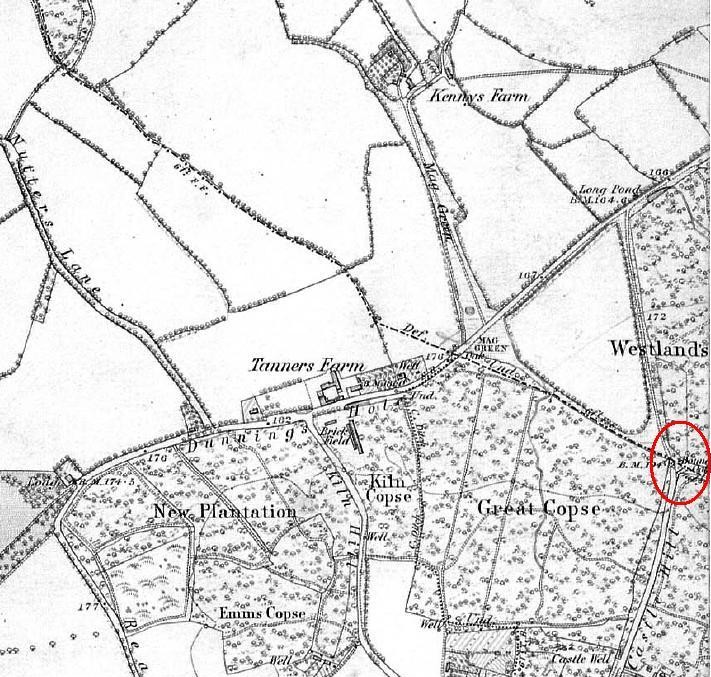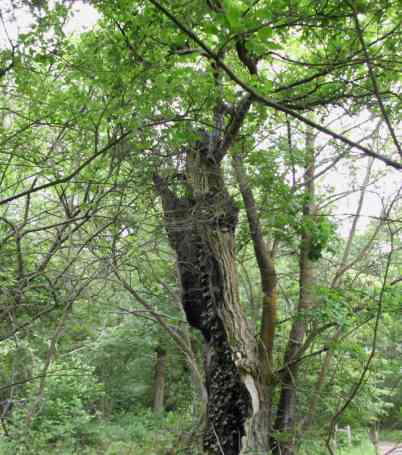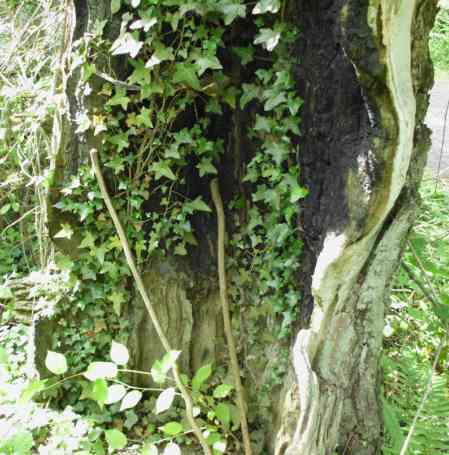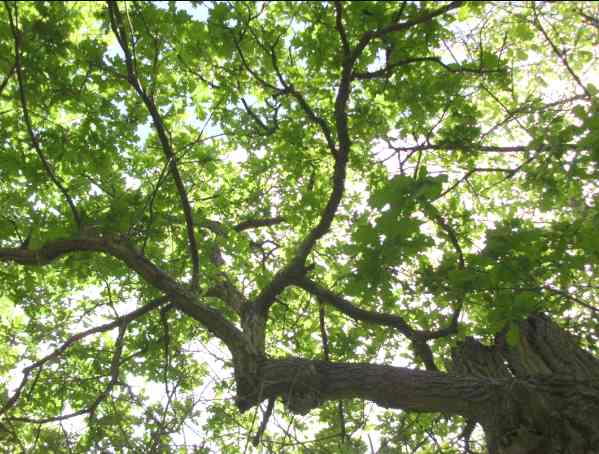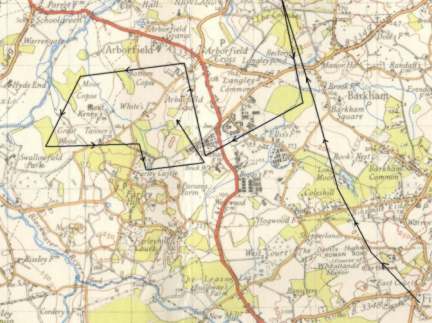
|
Arborfield
|
|
Properties
Related sites:
Wokingham District Veteran Tree Association (WDVTA) WDVTA Tree record for Bound Oak
|
Members of the Wokingham District Veteran Tree Association (WDVTA) are gradually working their way around the local area, recording all trees usually above a certain girth on a database. In Arborfield and Newland, many of these trees are oaks. One noteworthy example, known as Bound Oak, tree no. 4197 on the database, is so old that it has long since hollowed-out and decayed; however, in the second decade of the 21st Century, it was still alive as of May 2011 when the photos shown below were taken - see the WDVTA tree-record here - and still going strong as of May 2015. The tree is hundreds of years old. According to Beatrice Simonds, in the W.I. history of Arborfield and Newland of 1922, she said:
The boundary between Arborfield and Swallowfield is still marked by a tree, The tree can easily be found on the Ordnance Survey Pathfinder 1/25000 map as a local landmark (SU 75105 65615). Even on the old six-inch Ordnance Survey map published in 1876, it was marked as an antiquity. "Bound Oak", is shown on the right-hand edge of map XLVI: On this portion of the map, the road running from south-west to north-east is the Swallowfield Road. Bound Oak is on the junction of Castle Hill and Wokingham Lane (off the map to the right). By the way, Westlands Copse has long since gone, as has the brick kiln opposite Tanners Farm. Notice just how many wells served the locality in the 1870s. As of 2011, two segments of the hollow trunk are lying on the ground. However, about a third of the trunk remains standing, as shown on the photo below. At least twice in recent years, fires have deliberately been started in the hollowed-out trunk.
Ivy is now growing up on the inside of the trunk, as shown below.
The next photo is looking upwards to the branch, clearly showing leaves growing from the old oak.
The final view shows the tree from its 'good' side:
A good circular stile-free walk from Arborfield Cross will take you past Bound Oak as follows:
This walk should take around an hour and a half. LONGER WALK (includes some stiles, and takes two and a half hours): Follow the instructions as above until you reach Kennys Farm. Then:
In 2011, cuckoos could regularly be heard along
most of the route - at least three at the same tim However, cuckoos could also be heard on the other side of the village a day or so later, and one was successfully photographed in the field adjacent to Bearwood Lakes Golf Club, well-camouflaged against the sweet chestnut tree branch. Cuckoos have been heard every year since - including 2015.
Bound Oak was a well-known staging-point for the local hunt, as this report of the The Garth Hunt from the 'Reading Mercury' of February 20th 1926 shows:
The Garth dog pack met on Wednesday, at the Greyhound, Finchampstead. ... One fox crossed the road and ascended the steep hill. Leaving the church on the right, hounds ran their quarry over the Nine-mile-Ride, through Longmoor, over to Kidgham and by Barkham, over the road to the Coombes into Bear Wood, where they were run out of scent. Hounds cast about in the Coombes, hoping to pick up their hunted fox, but failing this, they came back to Barkham and drew Kidgham through. The next draw was the covers near the Arborfield Remount, and a fox was soon found, which led hounds away with a merry cry round Whitehall and Westlands. Leaving Arborfield Cross on the right, he crossed the road pointing for Moor Copse, then bearing left-handed went on to the Swallowfield Park covers, then re-crossed the road, running with some delightful music through the Farley Hill covers. [Warning: the casual way in which the remainder of the fox-hunt was described might be off-putting:] Keeping to the left, he ran on by the Bound Oak towards Farley Castle, then turned back by Westlands and Whitehall, to be killed in the open on the hill between the Bound Oak, Farley Hill, and Arborfield, after a really good hunt.
Bound Oak was actually the start of several Garth Hunt meets, including this one from the 'Reading Mercury' of 14th October 1933:CUB HUNTING. The Garth dog pack met on Thursday, October 5th, at The Bound Oak, Farley Hill, at 8 o’clock. Out during the morning were Major Sir Herbert R. Cayzer, Bart., M.P., the joint Master, Mr. Cayzer, Miss P. Cayzer, Miss E. Allfrey, Mrs. E. M. Sturges, Mr. Vivian Simonds, Miss P. Simonds, Mrs. G. Simonds, Major Edwards, Major Tanner, Lieut.-Colonel F. G. Barker, ex-Master, Miss Effie Barker, Mr. Pither, Mr. Simonds, Miss Ravenscroft, Miss Joan Ravenscroft, Mr. Ben Green, Mrs. Vere Allfrey, Mrs. Anderson, Mr. Hedges, etc. Westlands was blank. The next draw was Mr. Allfrey’s covers in Farley Castle Park, and then hounds proceeded over the road into the Big Wood. A view holloa was heard back towards The Bound Oak. Hounds ran towards Long Copse, and the fox turned short back and through Farley Castle covers, and was viewed over the top part of Farley Hill back into the Big Wood.Later hounds got well on the line, running round Hemmses with quite a good scent and a splendid burst of music, and seemed quite close to the fox at times. Eventually he broke away over the old lane, and ran round the Big Wood and got to ground just on the top part of the Big Wood. At Farley Hill Place a fox was found, which led hounds over to the lower part of Wyfolds. Hounds then drew all through Wyfolds, the gravel pits and gorse by Mr. Bowyer’s farm, and then Wheelers, and after a time a fox was on foot. Hounds hunted him round the cover and then across from Wheelers into Wyfolds, and back to Wheelers again, but scent seemed to fail. [We wonder how the reporter decided which names were worthy of mention, as opposed to being grouped under the abbreviation 'etc.']
|
||
|
Any Feedback or comments on this website? Please e-mail the webmaster |
